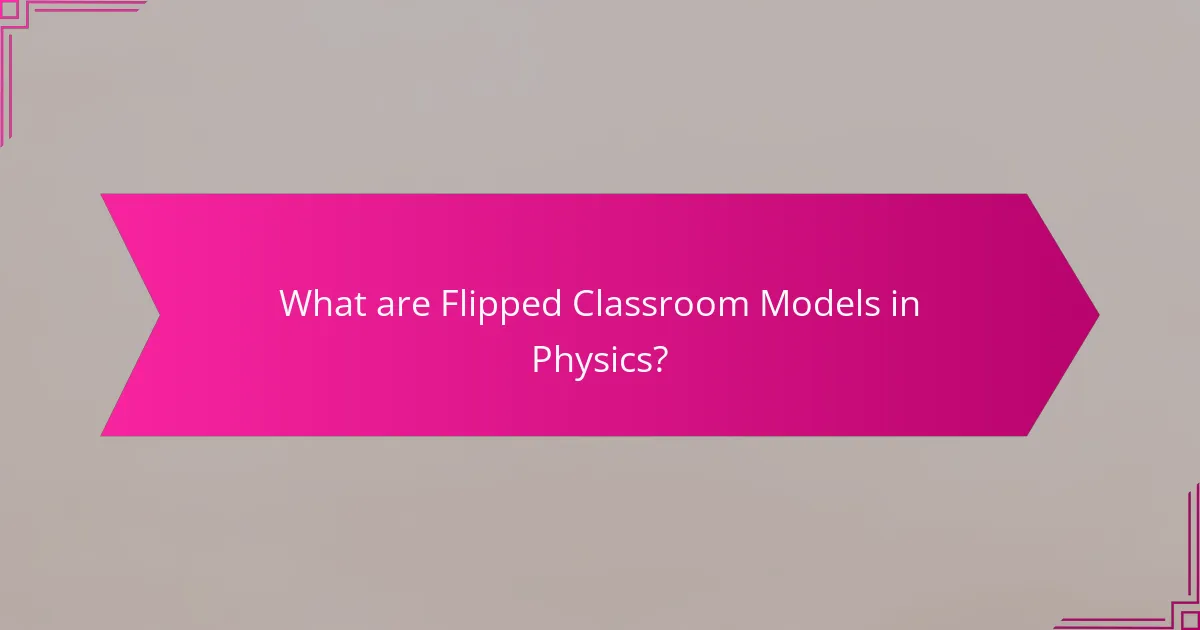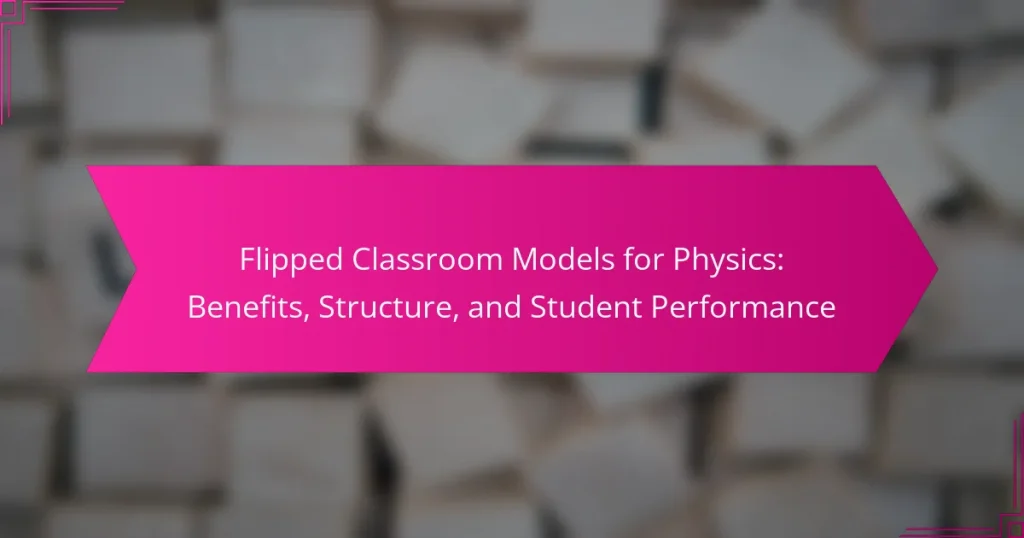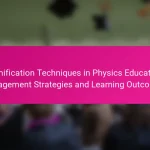Flipped classroom models in physics are instructional strategies that invert traditional teaching methods, allowing students to engage with new content outside the classroom through videos or readings. This approach maximizes classroom time for interactive activities, discussions, and problem-solving, thereby enhancing student engagement and comprehension of complex physics concepts. Research, including a study by Bishop and Verleger (2013), indicates that flipped classrooms can lead to improved student performance compared to conventional teaching methods. This article will explore the structure of flipped classroom models in physics, their benefits, and their impact on student performance.

What are Flipped Classroom Models in Physics?
Flipped classroom models in physics are instructional strategies that reverse traditional teaching methods. In this approach, students first engage with new content outside the classroom, typically through videos or readings. This allows classroom time to be used for interactive activities, discussions, and problem-solving. Research indicates that flipped classrooms can enhance student engagement and understanding of complex physics concepts. A study by Bishop and Verleger (2013) found that these models often lead to improved student performance compared to traditional methods.
How do Flipped Classroom Models differ from traditional teaching methods?
Flipped Classroom Models differ from traditional teaching methods by reversing the typical learning environment. In traditional methods, teachers deliver content in class and assign homework. In contrast, flipped classrooms assign content for students to learn at home, often through videos or readings. Class time is then used for interactive activities, discussions, or problem-solving. This approach promotes active learning and student engagement. Research shows that flipped classrooms can enhance understanding and retention of material. Studies indicate that students in flipped classrooms often perform better on assessments compared to those in traditional settings.
What are the key principles of Flipped Classroom Models?
Flipped Classroom Models prioritize student engagement through active learning. Students learn content at home, often via video lectures. Class time is dedicated to interactive activities, discussions, or problem-solving. This approach shifts the focus from teacher-centered to student-centered learning. It encourages collaboration among students during class. Teachers facilitate learning rather than delivering lectures. Research shows this model can improve student performance and retention. Studies indicate that students report higher satisfaction in flipped classrooms.
How is content delivered in a Flipped Classroom Model?
Content in a Flipped Classroom Model is delivered primarily through pre-recorded video lectures. Students access these videos outside of class time, allowing them to learn at their own pace. This model encourages active learning during class sessions. In-class time is then dedicated to discussions, problem-solving, and collaborative activities. Research shows that this approach enhances student engagement and understanding. A study by Bergmann and Sams highlights improved academic performance in students using this model. Overall, the Flipped Classroom Model shifts traditional teaching methods to a more interactive learning environment.
What are the benefits of using Flipped Classroom Models for Physics?
Flipped Classroom Models for Physics enhance student engagement and understanding. They allow students to learn at their own pace through video lectures. This model shifts traditional homework into the classroom, promoting active learning. Students can collaborate with peers during class time to solve problems. Teachers can provide personalized support in real-time. Research shows improved student performance in physics using this model. A study by Bergmann and Sams found that students in flipped classrooms scored higher on assessments. This approach fosters critical thinking and problem-solving skills in physics.
How do these models enhance student engagement?
Flipped classroom models enhance student engagement by promoting active learning and collaboration. These models encourage students to prepare before class, allowing for deeper discussions during class time. Active participation in class leads to increased motivation and interest in the subject matter. Research indicates that students in flipped classrooms report higher satisfaction and engagement levels compared to traditional settings. A study by Bishop and Verleger (2013) found that flipped classrooms foster improved student performance and engagement in STEM subjects. The interactive nature of these models cultivates a learning environment that supports peer interaction and feedback, further enhancing engagement.
What impact do Flipped Classroom Models have on student learning outcomes?
Flipped Classroom Models significantly enhance student learning outcomes. These models shift direct instruction outside of the classroom, allowing more time for interactive learning during class. Research indicates that students in flipped classrooms often achieve higher test scores compared to traditional settings. A study by Bishop and Verleger (2013) found that 73% of students reported improved engagement and understanding. Additionally, a meta-analysis by O’Flaherty and Phillips (2015) concluded that flipped classrooms lead to better academic performance across various subjects. This evidence demonstrates that the flipped classroom approach positively influences student learning outcomes in physics and other disciplines.
What is the structure of an effective Flipped Classroom Model for Physics?
An effective Flipped Classroom Model for Physics involves several key components. First, students learn new content through pre-recorded lectures or online resources at home. This allows them to engage with the material at their own pace.
Second, in-class time is dedicated to active learning strategies. Teachers facilitate discussions, problem-solving sessions, and hands-on experiments. This promotes deeper understanding and application of concepts.
Third, continuous assessment is integrated to gauge student progress. Formative assessments help identify areas needing reinforcement.
Lastly, collaboration among students is encouraged. Group work enhances peer learning and communication skills.
Research supports that this model improves student engagement and learning outcomes in Physics. For instance, a study by Bergmann and Sams highlights increased student performance through active participation.
What are the essential components of a Flipped Classroom structure?
A Flipped Classroom structure consists of several essential components. First, students engage with instructional content outside of class, often through videos or readings. This allows them to learn at their own pace. Second, in-class time is dedicated to interactive activities, such as discussions or problem-solving. This promotes active learning and collaboration among students. Third, teachers facilitate and guide students during these in-class activities. This role shift enhances support and engagement. Lastly, assessment methods are integrated to evaluate student understanding and progress. These components collectively create an effective learning environment.
How should lesson plans be designed for a Flipped Classroom?
Lesson plans for a Flipped Classroom should focus on pre-class preparation and in-class engagement. Educators must provide instructional videos or reading materials for students to review at home. This allows students to familiarize themselves with concepts before class. In-class time should be dedicated to interactive activities, discussions, and problem-solving exercises. Teachers should create opportunities for collaborative learning and hands-on experiences. Assessment methods should align with the flipped model, focusing on student understanding and application of knowledge. Research indicates that this approach enhances student performance and engagement in subjects like physics. Studies show improved learning outcomes when students actively participate in the learning process.
How does student performance compare in Flipped Classroom Models?
Student performance in Flipped Classroom Models generally shows improvement compared to traditional teaching methods. Research indicates that students in flipped classrooms often achieve higher test scores and demonstrate better engagement. For instance, a study by Bergmann and Sams (2012) highlighted that students in a flipped physics class scored an average of 15% higher on assessments than those in conventional settings. Furthermore, the interactive nature of flipped classrooms fosters collaborative learning, enhancing understanding of complex concepts. These models also allow for personalized pacing, catering to individual learning needs, which contributes to overall academic success.
What metrics are used to evaluate student performance in these models?
Common metrics used to evaluate student performance in flipped classroom models include test scores, participation rates, and assignment completion rates. Test scores assess knowledge retention and understanding of physics concepts. Participation rates indicate student engagement during in-class activities. Assignment completion rates measure students’ ability to manage their workload effectively. Additionally, peer evaluations and self-assessments can provide insights into collaborative skills and self-directed learning. These metrics collectively offer a comprehensive view of student performance in flipped classroom settings.
How do students perceive their learning experience in a Flipped Classroom?
Students generally perceive their learning experience in a Flipped Classroom positively. They appreciate the active learning environment created by this model. Many students report increased engagement during class activities. They value the flexibility of learning at their own pace through pre-class materials. Research indicates that students feel more prepared for in-class discussions and activities. A study by Bergmann and Sams found that students in flipped classrooms often demonstrate improved understanding of concepts. Additionally, students express a preference for collaborative learning opportunities found in this model. Overall, the Flipped Classroom enhances student perceptions of their educational experience.
What challenges might educators face when implementing Flipped Classroom Models?
Educators may face several challenges when implementing Flipped Classroom Models. One significant challenge is ensuring students complete pre-class assignments. Research shows that lack of student engagement with these materials can hinder the effectiveness of the model. Additionally, educators may struggle with technology access. Not all students have reliable internet or devices, which can create disparities in learning opportunities.
Another challenge is the need for proper teacher training. Educators must be adept at using technology and facilitating active learning. Studies indicate that insufficient training can lead to ineffective implementation. Classroom management can also become more complex. Teachers may find it difficult to monitor student progress and engagement during in-class activities.
Finally, resistance to change can be a barrier. Some educators may prefer traditional teaching methods, making it hard to adopt new strategies. All these factors can significantly impact the successful implementation of Flipped Classroom Models in physics education.
How can teachers overcome common obstacles in Flipped Classroom implementation?
Teachers can overcome common obstacles in Flipped Classroom implementation by utilizing effective strategies. First, they should provide clear instructions and expectations for students. This clarity helps students understand their roles in the learning process. Second, teachers can use diverse multimedia resources to engage students. Research shows that varied content can enhance understanding and retention. Third, establishing a supportive classroom environment encourages student participation. A positive atmosphere fosters collaboration and communication. Fourth, teachers can offer additional support for students who struggle with the self-directed learning model. This may include one-on-one check-ins or supplementary materials. Finally, continuous feedback from students allows teachers to adjust their approach. Regular assessments can identify areas needing improvement. These strategies collectively address the challenges of Flipped Classroom implementation effectively.
What resources are available to support educators in this transition?
Educators transitioning to flipped classroom models can access various resources. Professional development workshops are available to enhance teaching strategies. Online platforms offer courses specifically on flipped learning techniques. Educational organizations provide toolkits that include lesson plans and assessment strategies. Peer networks and forums enable educators to share experiences and best practices. Research articles and case studies demonstrate successful implementations of flipped classrooms. Many universities offer mentorship programs for educators seeking guidance during this transition. These resources collectively support educators in effectively adopting flipped classroom models in physics education.
What best practices can enhance the effectiveness of Flipped Classroom Models in Physics?
Best practices to enhance the effectiveness of Flipped Classroom Models in Physics include providing clear instructional videos. These videos should be concise and focused on specific concepts. Engaging students with interactive content promotes active learning. Incorporating formative assessments helps gauge student understanding. Facilitating collaborative learning encourages peer interactions and discussions. Offering timely feedback ensures students stay on track. Creating a supportive online environment fosters student engagement and motivation. Research indicates that these strategies can significantly improve student performance and comprehension in physics.
How can technology be leveraged to improve student engagement in Flipped Classrooms?
Technology can enhance student engagement in flipped classrooms by providing interactive learning tools. These tools include video lectures, quizzes, and discussion forums. Video platforms allow students to learn at their own pace. Interactive quizzes can assess understanding and provide immediate feedback. Discussion forums facilitate peer interaction and collaboration. Learning management systems centralize resources and track progress. Tools like polls and live chats can make in-class sessions more dynamic. Research shows that active learning strategies increase student participation and retention. A study by the Educause Review indicates that technology integration in education leads to higher engagement levels.
What strategies can be employed to assess student understanding effectively?
Formative assessments can be employed to assess student understanding effectively. These assessments provide ongoing feedback during the learning process. Techniques include quizzes, polls, and interactive discussions. Observations during group work also offer insights into comprehension. Peer assessments allow students to evaluate each other’s understanding. Self-assessments encourage reflection on personal learning. Research indicates that formative assessments improve student outcomes by 25% (Black & Wiliam, 1998). Implementing diverse strategies helps cater to different learning styles.
Flipped Classroom Models for Physics represent an innovative instructional strategy that reverses traditional teaching methods by allowing students to engage with new content outside the classroom. This article explores the key principles, structure, and benefits of flipped classrooms, emphasizing their impact on student engagement and performance in physics. The discussion includes how these models differ from conventional approaches, the essential components for effective implementation, and strategies for assessing student understanding. Additionally, it addresses potential challenges educators may face and offers best practices to enhance the effectiveness of flipped classroom environments.


